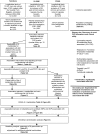Large-scale metabolomic profiling identifies novel biomarkers for incident coronary heart disease
- PMID: 25502724
- PMCID: PMC4263376
- DOI: 10.1371/journal.pgen.1004801
Large-scale metabolomic profiling identifies novel biomarkers for incident coronary heart disease
Abstract
Analyses of circulating metabolites in large prospective epidemiological studies could lead to improved prediction and better biological understanding of coronary heart disease (CHD). We performed a mass spectrometry-based non-targeted metabolomics study for association with incident CHD events in 1,028 individuals (131 events; 10 y. median follow-up) with validation in 1,670 individuals (282 events; 3.9 y. median follow-up). Four metabolites were replicated and independent of main cardiovascular risk factors [lysophosphatidylcholine 18∶1 (hazard ratio [HR] per standard deviation [SD] increment = 0.77, P-value<0.001), lysophosphatidylcholine 18∶2 (HR = 0.81, P-value<0.001), monoglyceride 18∶2 (MG 18∶2; HR = 1.18, P-value = 0.011) and sphingomyelin 28∶1 (HR = 0.85, P-value = 0.015)]. Together they contributed to moderate improvements in discrimination and re-classification in addition to traditional risk factors (C-statistic: 0.76 vs. 0.75; NRI: 9.2%). MG 18∶2 was associated with CHD independently of triglycerides. Lysophosphatidylcholines were negatively associated with body mass index, C-reactive protein and with less evidence of subclinical cardiovascular disease in additional 970 participants; a reverse pattern was observed for MG 18∶2. MG 18∶2 showed an enrichment (P-value = 0.002) of significant associations with CHD-associated SNPs (P-value = 1.2×10-7 for association with rs964184 in the ZNF259/APOA5 region) and a weak, but positive causal effect (odds ratio = 1.05 per SD increment in MG 18∶2, P-value = 0.05) on CHD, as suggested by Mendelian randomization analysis. In conclusion, we identified four lipid-related metabolites with evidence for clinical utility, as well as a causal role in CHD development.
Conflict of interest statement
The authors have declared that no competing interests exist.
Figures



Similar articles
-
A Non-Targeted Liquid Chromatographic-Mass Spectrometric Metabolomics Approach for Association with Coronary Artery Disease: An Identification of Biomarkers for Depiction of Underlying Biological Mechanisms.Med Sci Monit. 2017 Feb 2;23:613-622. doi: 10.12659/msm.896298. Med Sci Monit. 2017. PMID: 28151921 Free PMC article.
-
Association of Circulating Metabolites With Risk of Coronary Heart Disease in a European Population: Results From the Biomarkers for Cardiovascular Risk Assessment in Europe (BiomarCaRE) Consortium.JAMA Cardiol. 2019 Dec 1;4(12):1270-1279. doi: 10.1001/jamacardio.2019.4130. JAMA Cardiol. 2019. PMID: 31664431 Free PMC article.
-
Multilocus genetic risk scores for coronary heart disease prediction.Arterioscler Thromb Vasc Biol. 2013 Sep;33(9):2267-72. doi: 10.1161/ATVBAHA.113.301218. Epub 2013 May 16. Arterioscler Thromb Vasc Biol. 2013. PMID: 23685553
-
Fibrinogen, C-reactive protein and coronary heart disease: does Mendelian randomization suggest the associations are non-causal?QJM. 2004 Mar;97(3):163-6. doi: 10.1093/qjmed/hch025. QJM. 2004. PMID: 14976273 Review. No abstract available.
-
Markers of inflammation and risk of coronary heart disease.Dis Markers. 2009;26(5-6):217-25. doi: 10.3233/DMA-2009-0646. Dis Markers. 2009. PMID: 19773611 Free PMC article. Review.
Cited by
-
Screening of sphingolipid metabolism-related genes associated with immune cells in myocardial infarction: a bioinformatics analysis.J Thorac Dis. 2022 Aug;14(8):2987-2996. doi: 10.21037/jtd-22-1041. J Thorac Dis. 2022. PMID: 36071762 Free PMC article.
-
Statistical Workflow for Feature Selection in Human Metabolomics Data.Metabolites. 2019 Jul 12;9(7):143. doi: 10.3390/metabo9070143. Metabolites. 2019. PMID: 31336989 Free PMC article. Review.
-
The metabolites urobilin and sphingomyelin (30:1) are associated with incident heart failure in the general population.ESC Heart Fail. 2019 Aug;6(4):764-773. doi: 10.1002/ehf2.12453. Epub 2019 May 30. ESC Heart Fail. 2019. PMID: 31148414 Free PMC article.
-
Metabolomic Profiling of Adults with Congenital Heart Disease.Metabolites. 2021 Aug 9;11(8):525. doi: 10.3390/metabo11080525. Metabolites. 2021. PMID: 34436466 Free PMC article.
-
Correlation of Serum N-Acetylneuraminic Acid with the Risk of Moyamoya Disease.Brain Sci. 2023 Jun 5;13(6):913. doi: 10.3390/brainsci13060913. Brain Sci. 2023. PMID: 37371391 Free PMC article.
References
-
- Shah SH, Bain JR, Muehlbauer MJ, Stevens RD, Crosslin DR, et al. (2010) Association of a peripheral blood metabolic profile with coronary artery disease and risk of subsequent cardiovascular events. Circ Cardiovasc Genet 3: 207–214. - PubMed
-
- Wilson PW, D'Agostino RB, Levy D, Belanger AM, Silbershatz H, et al. (1998) Prediction of coronary heart disease using risk factor categories. Circulation 97: 1837–1847. - PubMed
Publication types
MeSH terms
Substances
LinkOut - more resources
Full Text Sources
Other Literature Sources
Medical
Molecular Biology Databases
Research Materials
Miscellaneous

